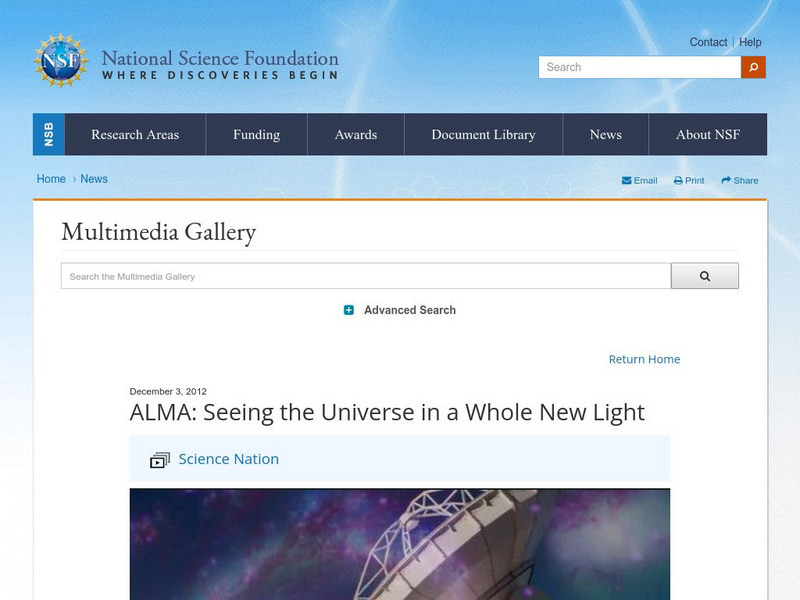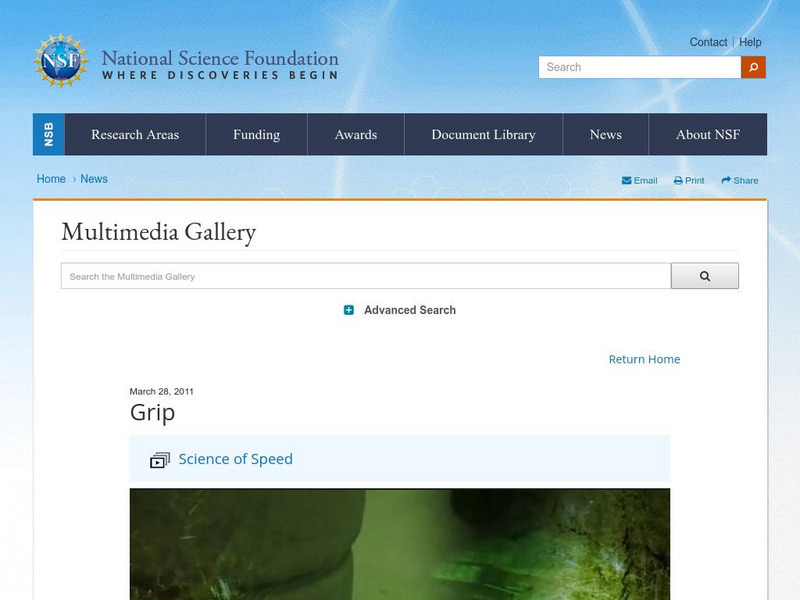Hi, what do you want to do?
National Science Foundation
National Science Foundation: Mysteries of the Brain: Brain Computer Interface
Scientists at the University of Washington are developing devices that rely on brain-computer interfaces which register task-specific brain activity, and then use the information to empower the devices to perform those tasks. [4:54]
National Science Foundation
National Science Foundation: When Nature Strikes: Tornadoes
Tornadoes can form in minutes, making early and accurate warnings crucial to saving lives. Howard Bluestein at the University of Oklahoma and Adam Houston at the University of Nebraska are trying to understand why some storms produce...
National Science Foundation
National Science Foundation: Green Revolution
A10-part video series about renewable energy resources.
National Science Foundation
National Science Foundation: When Nature Strikes: The Science of Natural Hazards
The National Science Foundation's (NSF) Directorate for Geosciences has partnered with NBC Learn and the Weather Channel to produce a 10-part video series that explores the science of natural disasters and research to avert their human...
National Science Foundation
National Science Foundation: Megathrust Earthquakes
Experts warn that an offshore quake powerful enough to discharge a tsunami could hit the U.S. West Coast anytime. QUEST Northwest talks with geologists and seismologists about cutting edge research in earthquake prediction, and what it...
National Science Foundation
National Science Foundation: Science of Nhl Hockey: Projectile Motion
Unlike a slap shot, an NHL wrist shot isn't about brute power. It's about precision - putting the puck in the exact spot where the goalie can't reach it. A wrist shot is also a perfect example of what's known in physics as projectile...
National Science Foundation
National Science Foundation: Innovation Nation: Tiny Batteries
Researchers at Princeton University have developed a technique to transfer microscopic materials by blasting them from one place to another with a laser. The tiny patterns they make help pack more into electronic screens. See how it...
National Science Foundation
National Science Foundation: T Science in Motion: Teaching Robots to Swim
Watch a swimming robot help researchers study marine animals. What they find will help engineers design next generation underwater vehicles. [1:27]
National Science Foundation
National Science Foundation: True Confessions of a Tornado Chaser
The president of the Center for Severe Weather Research discusses how thunderstorms give birth to violent tornadoes. [2:20]
National Science Foundation
National Science Foundation: Alma Seeing the Universe in a Whole New Light
Take a peek though the Atacama Large Millimeter/submillimeter Array telescope, or ALMA, and find out the scientific possibilities of this technology. [2:30]
National Science Foundation
National Science Foundation: Medicine and Engineering Join Forces to Restore Disfigured Faces
Patients who have suffered devastating facial injuries sometimes go to great lengths to hide themselves from public view. A plastic surgeon at Ohio State University's Wexner Medical Center is finding better ways to restore a normal...
National Science Foundation
National Science Foundation: New Co Bots Are 'Help on Wheels'
Meet CoBot - short for "Collaborative Robot." You might call it "help on wheels." Scientists are developing CoBots, autonomous indoor service robots to interact with people and provide help "on the go." Users request a task to be done,...
National Science Foundation
National Science Foundation: Researchers Map Hurricane Sandy Impact in New York City
While many scientists will be studying Superstorm Sandy for years to come, some researchers are focused instead on how to make communities less vulnerable to such a storm. [2:55]
National Science Foundation
National Science Foundation: Humanoid Robot 'Russell' Engages Children With Autism
Look at a humanoid robot, nicknamed "Russell," who works with autistic children on their ability to imitate others, which is a skill important for learning. The robot is designed so as to not overstimulate or overwhelm a child with...
National Science Foundation
National Science Foundation: Assessing the Impact of Military Service on Our Returning Veterans
Jay Teachman and his colleagues from Western Washington University studied employment, health and the family life of veterans of World War II, the Vietnam War and the most recent military eras to learn how they had adjusted to civilian...
National Science Foundation
National Science Foundation: Waterfall Climbing Fish Performs Evolutionary Feat
The species of Goby fish, Sicyopterus stimpsoni, also known as the "inching climber," thrives in the waters off Hawaii. To reach its freshwater spawning area, it must scale a waterfall, hundreds of feet high, using suction cups on its...
National Science Foundation
National Science Foundation: Perception of Danger in Tornado Alley
A psychologist and colleagues examined how the people who lived in Tornado Alley viewed the risk of future tornadoes after they had survived the one that hit Iowa City in 2006. Understanding this could help with preparing and responding...
National Science Foundation
National Science Foundation: Science of Speed: Momentum and Time
Increasing the time of a collision from a tenth of a second to two tenths of a second can make a huge difference in the number of G's a driver experiences. The car, the track, seat belts, and seat construction spread out the force of...
National Science Foundation
National Science Foundation: Science of Speed: Firesuits
"Frightening" is how Jeff Gordon describes fire, even though he knows he's protected head to toe (and right down to his underwear) by fire-resistant Nomex fabric. Firesuits and the associated gear don't just protect drivers from fire,...
National Science Foundation
National Science Foundation: Green Revolution: Microbes
In Bruce Logan's lab at Penn State University, researchers are working on developing microbial fuel cells (MFCs) that can generate electricity while treating wastewater. They are also researching methods to increase power generation from...
National Science Foundation
National Science Foundation: Science of Speed: Power
Think of 850 horses all lined up - that's how much power a NASCAR Sprint Cup engine has. The engine's job is to convert the energy in fuel to speed. NASCAR engines do it faster and more efficiently than passenger car engines. [4:52]
National Science Foundation
National Science Foundation: Profiles of Scientists and Engineers: Electrical Engineer
Meet Yael Maguire, an electrical engineer who loves his job at Thing Magic. Yael has been designing and building things his whole life. He develops Radio Frequency Identification technology. RFID tags have many applications in the real...
National Science Foundation
National Science Foundation: Science of Speed: Grip
Success in auto racing depends on the grip of a car's tires. Grip is the frictional force that holds the tires on the track. Aerodynamic features of a car also improve a car's grip. [5:02]
National Science Foundation
National Science Foundation: Science of Speed: Load Transfer
The corners of a NASCAR track are divided into three parts because the car's grip changes in different parts of the turn. A race crew must try to minimize load transfer by making adjustments based on a car's centre of gravity. [5:05]








